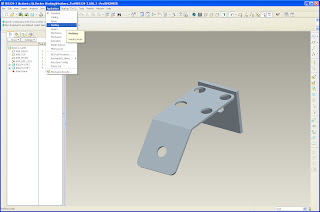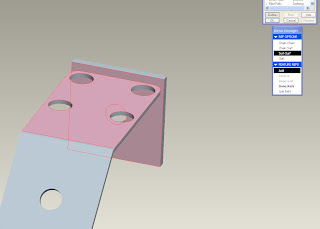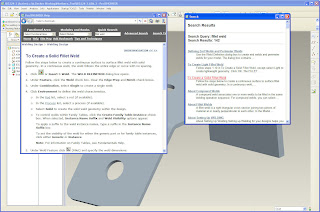A while back I had posted some pictures of an immaculate steel staircase being built. We were asked to create a 3D model along with the drawings and prints so that the welder could put this thing together properly. Here are a few images of the final piece.
December 29, 2009
December 14, 2009
SunArx’s Solar Trackers On Track Through Simulation and Analysis
Wanted to throw my guys a nice pat on the back. About a year ago we worked on a solar panel tracking system, not the electronics but the mechanism and strength of it. Its on the market now and our marketing department put together a nice article that got published in a couple different e-zines.
Take a look it's pretty interesting.
Posted by Allen Caldwell at 12/14/2009 07:59:00 AM
September 03, 2009
Staircase Development
The PDC team has started work on an architectural project, a first for us. An extravagant residential staircase is being developed from structural and plate steel.
The team is utilizing Pro/E to create the stairs so that the individual steel pieces can be documented and data may be provided to the manufacturer. The manufacturer will then use the data to cut the steel parts with his torch.
We are just getting started, more images to come!
Posted by Nate at 9/03/2009 12:37:00 PM
August 05, 2009
In Depth Help Files
PTC has a help topic collection that is far more in depth and broken down into modules. These documents explain everything from what each button does to the theory behind the Mechanica solver.
Posted by Nate at 8/05/2009 10:32:00 AM
Labels: Help, Tips'n'Tricks
Create a Fillet Weld in Pro/E
Earlier this week a customer was having difficulty creating and showing a fillet weld in Pro/E WF 4. I put together a quick how to create a fillet weld and decided to post it here for the benefit of others. The steps are valid for previous versions of Pro/E WF but for WF 5 the Weld interface has been updated to utilize the dashboard like an extrusion or revolve feature so the steps are a little different for that.
1. Select APPLICATIONS, WELDING from the Pro/E drop down menu.

2. Select the WELD FEATURE from the tool bar or from the INSERT drop down menu.
a. Define the Weld parameters/type in the WELD DEFINITION dialogue box.
3. For a fillet weld select a set of surfaces that are in the same plane. This example shows only one surface being selected.

a. Select DONE REFS when you are done selecting the first set of surfaces.
4. For a fillet weld select a second set of surfaces that are in the same plane.

a. Select DONE REFS when you are done selecting the first set of surfaces.
5. Specify if you want the weld to be continuous, intermittent, the entire length, or set the ends.

6. Specify the material side for the weld. The arrow points in the direction the weld will be added.

7. At this point specify any other options for the weld or hit the OK button to complete the weld.

8. For additional information about welds search the Pro/E help functionality or PTC's Knowledge Base.

Posted by Matt Decker at 8/05/2009 08:57:00 AM
Labels: Pro/Engineer, PTC, Tips'n'Tricks, Wildfire
August 03, 2009
Free Lunch - Start Parts and Formats
So it was my turn to perform the Friday Free Lunch here at EAC. The topic was Start Parts and Formats. This is something not new to me at all. We in the PDC do this type of setup and configuration for many of our customers and in fact have a small defined consulting engagement set up already for this.
If you are interested in having EAC do this please contact us or your current Sales Representative.
If you would like to download the standard borders that were discussed, please click here.
There were some remaining questions from the webinar and I'll try to get them all answered here.

Q: Does the analysis feature in the footer cause the model to be marked as modified? This would be a disadvantage for using it in Windchill. For clarification, it would mark model as modified just by retrieving it into session?
A: If the analysis feature is modified (the model must have been modified) the model becomes modified and then the answer is yes. You could also investigate setting that feature as read-only, to stop this behavior. By default by retrieving a model in session it is not marked as modified.
Q: Are parameters case-sensitive? (thinking of attributes in Windchill)
A: I would say no they are not. Even if you type them in lowercase or a combination of upper and lower, once you save the newly added parameters, they become upper case. The attributes in Windchill are mapped to the parameters in the Pro/E Data.
Q: Is there a difference between renaming a datum plane in the model tree as opposed to renaming in properties?
A: No, there is no difference in renaming the model in the model tree versus using the feature property dialog box to rename the datum plane or any other feature.
Q: Is everything we learn today relative to Wildfire 3?
A: Yes, the items covered today are the same as in Wildfire 3.0.
Q: Can you use bitmaps for symbols?
A: No, but you can use other imported data such as AutoCAD files.
Q: I missed it, how do you start creating a start part?
A: I would recommend starting from the default parts provided by PTC. But if you want to create a new file simply create a new file, uncheck the "USE DEFAULT TEMPLATE", choose empty for your template and then begin inserting the coordinate system, datum planes, parameters, relations, layers and views.
Q: How do you save these files to reuse them?
A: Start parts and format files are saved just like any other file in Pro/Engineer. You can either place them in the default install location or in your config file located central location.
Q: How about the config.sup file? How do you create this file?
A: The config.sup file is simply a config.pro file that is renamed to the .sup extension. An option that is set in the config.pro file cannot override the config.sup file.
Q: If the parameters are locked how can they be unlocked? Pasword?
A: Locked parameters are typically created by a data management system or a relation. They cannot be unlocked unless you remove the relation that is driving/creating the parameter. Data Management parameters cannot be unlocked.
Q: What does the Designate Box do?
A: It really does two things, first it allows you to populate the parameter as you are creating the model. And second it allows you to tie it to attributes in Intralink or Windchill based PDM systems.
Q: Should parameters for drawing templates be put into the model or the drawing? Or does it even matter where they reside?
A: It really depends on how you want the data controlled. We prefer to have all the necessary parameters in the model as this is your source. If you want to have drawing parameters created they will only be able to be used on that particular drawing.
Q: For logos, can you import from an AutoCAD or Jpeg file?
A: You can import autoCAD data as sketch entities and use them. You can insert a BMP as an Object but not a JPEG. To do this go to INSERT>OBJECT.
Q: Where do you open this format from?
A: Tthe format file is opened from the default location
Thanks to everyone for your attendance, hopefully the content shown was of use.
Posted by Allen Caldwell at 8/03/2009 01:08:00 PM
Labels: consulting, Friday Webcast, mechanical engineering, Pro/Engineer, Tips'n'Tricks
August 01, 2009
New Layout
Well it's time. I've searched over and over and can't find just the right layout to use or template to start with. So we will start with a simple white background and see where we go from here.
We (the PDC Team) hope to update this blog at least weekly. Hopefully it will contain useful information for you.
Check back often.
Posted by Allen Caldwell at 8/01/2009 10:43:00 PM
July 28, 2009
Prepping an Analysis Model with Pro/Engineer
We had a few questions from the Friday webcast this past week. Replays can be found here. Thank you to all of you who attended. Questions from the webcast are below!
Posted by Nate at 7/28/2009 11:06:00 AM
Labels: Friday Webcast, MECHANICA, Tips'n'Tricks
June 01, 2009
Great Search Engine
At EAC we tend to do quite a bit of research and different types of math calculations. Typically we use MathCAD whenever possible, but there is a really great search engine that has recently showed up.
Check it out
You type in almost any math formula, dates, cities and even family geneology trees.
Posted by Allen Caldwell at 6/01/2009 10:34:00 AM
Labels: EAC, engineering, product development
May 19, 2009
EAC Patent Contributors

Below are links to various patents EAC has contributed to or done design work on. These will all open in Google Patents.
There are many more to come....
Steinel Carriage Welder
Trigger Pourer Solutions
Wagner - Texture Sprayer
Xtend and Climb #1
Xtend and Climb #2
Wagner - Collapsible Cart
Wagner - Paint Pump Stand
Wagner - Paint spray pump with handle
Wagner - Paint spray pump with rear louvers
Wagner - Paint spray pump with side louvers
Wagner - Collapsible cart for paint spray pump
Posted by Allen Caldwell at 5/19/2009 04:17:00 PM
Labels: consulting, engineering, mechanical engineering, Pro/Engineer, product development, Wildfire
April 06, 2009
EAC PDC - Customized Mentoring
Need specific mentoring around a topic in Pro/Engineer? EAC PDC has power users ready to deliver a specific topic to your team. The following list are topics we have presentations ready to go. We can deliver on site or using remote methods. Don't let the economy or travel costs stop you from developing a great engineering and design team
- Drafts - Simple and Advanced
- Inheritance Features and Use
- Mechanism and Design Animation
- Rounds - Simple and Advanced
- Simplified Representations
- Surface and Curve Tricks
- Sweeps
- Top Down Design Methodology
- Import Data Doctor
- Failure Resolution
- PTC Tech Support - How to Utilize and effectively navigate.
Posted by EAC at 4/06/2009 09:25:00 AM
Labels: consulting, engineering, mechanical engineering, medical design, Pro/Engineer, product development, Wildfire
March 31, 2009
EAC PDC Contact
EAC Product Development Center
14501 Judicial Rd
Suite 10
Burnsville, MN 55306
T: 888-225-7579
F: 952-435-2440
Email: pdc@eacpds.com
Posted by EAC at 3/31/2009 11:00:00 AM
Labels: EAC, engineering, PDC, Pro/Engineer, product development, PTC
Services
Our Engineering Team leverages years of experience and an extensive knowledge of the engineering disciplines to provide our customers fast, innovative design services. EAC has worked with hundreds of customers on more than 1000 project.
How can we help you?
CAE Competencies:
- General Solid Modeling
- Sheetmetal Modeling
- Detailing and Drafting
- Complex Assembly Management
- Digital Simulation
- Digital Analysis
- Tooling Design
- Manufacturing Process (NC)
- Wire and Pipe Routings
- Digital Renderings
- Machining
- Sheetmetal
- Injection Molding
- Blow Molding
- Rotation Molding
- Thermoforming
- Die Cast
- Extrusion
- Durable Goods
- Consumer Goods
- Industrial Products
- Mold Design
- Medical Devices
- Defense
- Automotive
- Pro/Engineer
- Windchill Projectlink
- Windchill PDMLink
- Routed Systems Designer
- Mechanica
- CFDesign
- MathCAD
- SolidWorks
- Ansys
- Autodesk Inventor
Posted by EAC at 3/31/2009 10:52:00 AM
Labels: EAC, engineering, medical design, PDC, Pro/Engineer, product development, PTC
EAC Completes Medical Device Project
The PDC recently successfully completed a project for a forward thinking medical device developer. If you are a medical device developer contact us today to find out how the Product Development Center can help you meet deadlines and create a rock-solid design.
Posted by EAC at 3/31/2009 10:31:00 AM
Labels: EAC, engineering, medical design, PDC, Pro/Engineer, product development
Cyberoptics Boosts Productivity with EAC
EAC supported CyberOptics' design initiative by placing an engineer onsite to assist with design and publishing tasks. Placing EAC's resource onsite increased CyberOptics' design team's productivity level while minimizing the impact on existing resources.
Posted by EAC at 3/31/2009 10:26:00 AM
Labels: Cyberoptics, EAC, engineering, PDC, Pro/Engineer, product development
Interesting Links
The PDC site
Pro/Engineer WIKI
Subdout.com - A new website for freelance and design groups.
Posted by EAC at 3/31/2009 10:14:00 AM
What and Who is the PDC - Extensioneering
The EAC Product Development Center is a full range product development services provider. We're staffed with degreed engineers who are "Power Users" of the PTC product line and proficient in many other industry standard softwares.
Our designers and engineers leverage their knowledge, experience and a wide spectrum of tools to consistently deliver real-world designs of new and exciting products ranging from medical devices to consumer goods to industrial equipment.
Our team offers the following Extensioneering;
- Art to Part Design
- Industrial / Mechanical / Electrical Design
- Design for Manufacturability
- Plastic Part Design
- Thermal / Fluid / Structural Analysis
- Design Validation
- Rapid Prototyping services
Posted by EAC at 3/31/2009 09:31:00 AM
Labels: PDC, Pro/Engineer, product development, PTC
January 01, 2009
Project Portfolio
Check back soon as we'll be posting examples of projects soon.
Posted by Allen Caldwell at 1/01/2009 03:46:00 PM

























